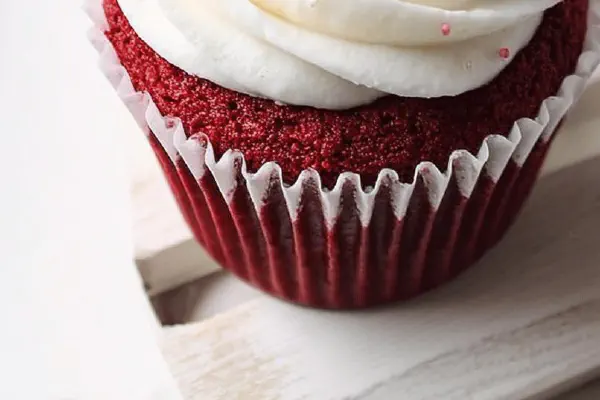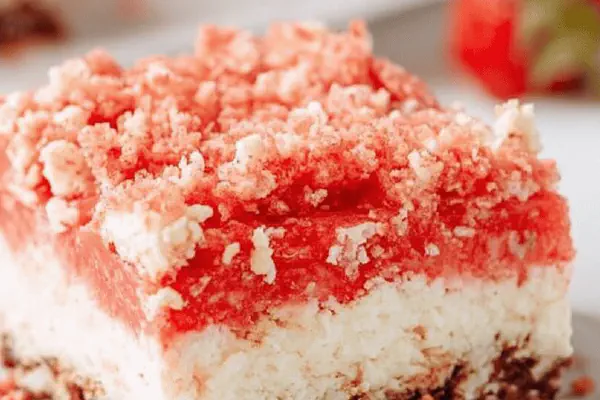Green Velvet Cupcakes

By Emma
Certified Culinary Professional
Ingredients
- 2 ½ cups all-purpose flour, sifted
- ⅓ cup unsweetened cocoa powder, good quality
- 2 ½ teaspoons baking powder
- 1 teaspoon baking soda
- ½ teaspoon salt
- ¾ cup unsalted butter, softened
- ¼ cup vegetable oil (neutral flavor, like canola)
- 1 ⅓ cups granulated sugar
- 3 large eggs
- 1 ½ teaspoons pure vanilla extract
- 15 drops green liquid food coloring
- 1 tablespoon white vinegar (or apple cider vinegar as substitute)
- 1 cup buttermilk, room temperature (substitute 1 cup milk plus 1 tablespoon lemon juice let sit 5 minutes)
- 8 oz cream cheese, room temp
- ½ cup unsalted butter, room temp
- ⅓ cup heavy cream (or half and half, but heavier is better)
- 1 teaspoon vanilla extract
- ⅛ teaspoon fine sea salt
- 3 ½ cups powdered sugar, sifted
- Sprinkles of choice for garnish
About the ingredients
Method
Cupcakes
- Preheat oven 345 to 355°F range. Line two 12-cup muffin pans with standard cupcake liners. Set aside.
- Mix flour, cocoa powder, baking powder, baking soda, and salt in a small bowl. Whisk to combine evenly.
- In large bowl, cream softened butter, oil, and sugar with handheld or stand mixer on medium speed. About 1 to 3 minutes, light and airy. Avoid overbeating, stops graininess but don't go paste.
- Add eggs one by one. Incorporate each completely before next. Look for evenly mixed with no streaks or lumps. Key for smooth batter.
- Add vanilla, green food coloring drop by drop, beat 1-2 minutes till even green color, then vinegar last, just blend, no overmixing—vinegar wakes cocoa flavor.
- Alternate dry mix and buttermilk in thirds. Start with ⅓ dry into wet; beat low speed short bursts till dry disappears. Add half buttermilk, low speed same. Repeat with second ⅓ dry, rest buttermilk, final ⅓ dry. Avoid overmixing; batter looks thick, glossy, some tiny lumps are okay.
- Fill liners two-thirds full for rising room. Tap pan once on counter to release air bubbles.
- Bake 18-23 minutes. Visual cues: domed top with slight cracks, edges pulling from liners, toothpick inserted near center comes out with few moist crumbs, not wet batter.
- Cool cupcakes in pan 4-6 minutes to settle, then transfer to wire rack, complete cooling vital before frosting or cream cheese melts and slides.
Frosting
- Beat room temp cream cheese and butter on medium speed for 2-3 minutes until creamy, no lumps. Scrape sides intermittently.
- Add heavy cream, vanilla, salt; mix till incorporated, creamy but still thick. Don’t whip heavy or it gains volume but loses spreadability.
- Add sifted powdered sugar in ½ cup increments, beating on low speed after each addition. Stop once frosting holds shape but is not grainy or too stiff. Should be thick enough to pipe but also smooth under spreading knife.
- Spread or pipe frosting onto cooled cupcakes. Decorate with sprinkles of your choice immediately before serving.
- Store frosted cupcakes covered in fridge up to 3 days; bring to room temp before eating to soften frosting.
===
Cooking tips
Chef's notes
- 💡 Butter and oil combo matters. Too warm butter turns oily, cold butter clumps. Creaming low to medium speed traps air, key for rise. Mix sugar and fats until pale, light texture but no graininess. Skip or rush this, dense batter. Timing around 1-3 minutes usually works, no more.
- 💡 Eggs room temp—cold eggs shock batter, curdle mixes. Add one at a time, fully absorbed before next. If breaks, low speed mixing can fix. Don’t pour all at once, leads to lumps, rough crumb. Patience here equals smooth batter, shine surface, no streaks.
- 💡 Vinegar last, small increments only; reactant with baking soda, lifts cupcakes, brightens cocoa flavor. Overmix after vinegar? Lost leavening, flat cupcakes. Vinegar also tames sweetness, subtle tang that cuts heaviness. White or apple cider vinegar work; cider adds earthiness.
- 💡 Alternate dry and wet additions in thirds, low speed mix. Dry fully incorporated but batter still thick, shiny with tiny lumps ok. Skip fast mixing here or batter toughens; gluten develops fast if ignored. Batter texture elastic, not runny or dense. Watch dryness spots after mixing.
- 💡 Cupcake dome visual cues include slight cracked top edges pulling from liners. When toothpick comes out with moist crumbs, but no wet batter. Oven temps vary, watch closely; 345-355°F middle rack best. Tap pan once after filling liners to release bubbles, no air holes inside.
- 💡 Cool 4-6 minutes in pans for crumb settling; too fast removal breaks cupcake. Transfer to wire rack, full cool essential before frosting. Warm cakes melt cream cheese frosting; slides, messy. Frosting consistency thick but pipeable, smooth to spread. Add powdered sugar slowly, sifted always to avoid grainy frost.
Common questions
Can I swap butter with oil only?
Oil alone replaces some butter, gives moist crumb but less flavor richness. Use more butter if skipping oil. Oil is neutral, lacks butter mouthfeel. Butter traps air when creamed, oil doesn’t. Balance adjusts texture, flavor. Could try but results differ; crumb more dense sometimes.
What if I don’t have buttermilk?
Use 1 cup milk plus 1 tbsp lemon juice or vinegar, let sit 5 mins. Mimics acidity of buttermilk, activates baking soda. No buttermilk makes crumb drier, less tender. Avoid just milk alone, cupcakes can turn crumbly. Acidity key in raising and flavor balance.
Frosting turns runny or stiff?
Too runny? Add more powdered sugar gradually, mix low speed. Too stiff? Add splash heavy cream or half and half slow until right texture. Over-whipping cream thickens but lowers spreadability. Room temp cream cheese and butter essential; cold chunks cause lumps, warm makes it soupy, no pipe hold.
How to store frosted cupcakes?
Covered in fridge up to 3 days is good. Bring to room temp 20 minutes before eating softens frosting. If frosted and warm, frost slides off. No cover, frosting hardens and crusts. Freeze uniced batter for prep ahead but frost fresh after thaw. Real talk, fresh best but fridge manages shelf life.



